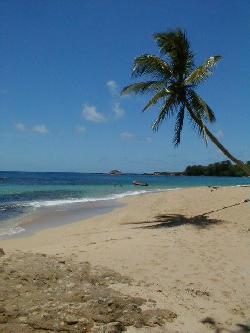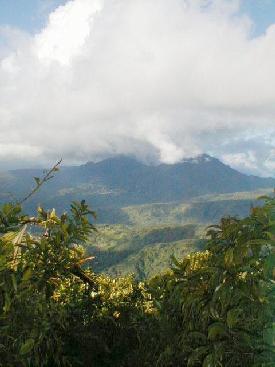


Welcome to Dominica.



From the mountain peaks rising to almost 5,000ft to the submerged volcanic
craters with dramatic vertical walls, it's no wonder Dominica will take your
breath away at every turn. Explore the site to find out what makes Dominica one
of the best places in the Caribbean to
dive,
whale & dolphin watch,
hike,
bird watch, explore a pristine
tropical rainforest or simply relax on one of our secluded beaches. With
more trails,
waterfalls and rivers than many of our neighbouring islands put together,
Dominica has indeed something for everyone.
| It is the largest and most mountainous of the the Windward Islands, with an area of 289.5 sq. miles. It is 29 miles long and 16 miles at its widest. The formal name Commonwealth of Dominica is often used to distinguish it from the Dominican Republic (incidentally, the Zip code 00109-8000 ensures mail isn't mis-sent to the DR). |
It has several peaks of over 3,000', the tallest of which are Morne Diablotin (4,747') and Morne Trois Pitons (4,600').
Dominica is famous for its tropical rainforest, and the many rivers and waterfalls which result from the high rainfall in the interior. In addition, its volcanic origins manifest themselves most noticeably in the Boiling Lake (one of the largest of its kind in the world) and many other smaller fumaroles around the island (including at least one underwater). Moreover, it is widely acknowledged to be both one of the best dive sites and a prime whale watching location in the region (if not world).
Dominica's population is around 71,000, of which 20,000 live around the capital city, Roseau (pronounced 'Ro-zo'), which is located on the south-west coast. Roseau was named after the French name for the reeds that grow by the river (interestingly, there is a Roseau in Minnesota named for the same reason).
The second largest city is Portsmouth in the north-west. Other conurbations of note include Marigot in the north-east, and Grand Bay in the south.
English is the official language but a French-based Creole (kwéyòl) is widely spoken, especially in outlying villages. This reflects an often turbulent history in which the island would be assigned to Britain by a treaty with the French, who would promptly break it and try to regain control of Dominica. Throughout and to the present day the original inhabitants, the Caribs, tried to coexist. In 1903 they were assigned a 3,700 acre Territory in the north-east where around 3,000 live today.
Electricity is 220/240 volts, 50 cycles.
Water is safe to drink.
From the US, American Eagle flies direct into Melville Hall from San Juan. American Airlines also flies via San Juan into Antigua . From Antigua, Barbados and St. Lucia the regional carriers LIAT & Caribbean Star offer connections to Melville Hall. British Airways also flies into Antigua, St. Lucia and Barbados. Air France connects via Martinique and Gualeloupe.
Tip: To get the best view of the island as you fly in:- flying north into Canefield Airport (from for example, St. Lucia), sit on the right of the aircraft. Flying south (from Antigua), sit on the left. Sit on the opposite side if flying into Melville Hall Airport. This tip will give you superb views of the island!
Distances to major cities
| From | To |
Miles
|
Km.
|
| Roseau | Antigua |
156
|
251
|
| Bridgetown, Barbados |
167
|
268
|
|
| San Juan, PR |
409
|
659
|
|
| Caracas, Venezuela |
508
|
817
|
|
| Miami, FL |
1447
|
2329
|
|
| New York, NY |
1932
|
3109
|
|
| Toronto, Canada |
2253
|
3626
|
A valid passport and onward/return ticket are required for stays of up to 21 days. US and Canadian citizens may use proof of citizenship with photo. French nationals may use a Carte identite for stays up to two weeks.
There are three main sea ports. Woodbridge Bay is one mile north of Roseau; both the Roseau Ferry Terminal and the Cruise Ship Berth are located on the Bayfront of Roseau itself, within close proximity to the business and shopping areas of the capital.
There are a number of inter-island high-speed catamaran ferry services connecting Dominica to both the neighboring French islands and St. Lucia, including L'Express Des Iles and Caribbean Express
Dominica in the Diving News
Ocean Realm
Magazine:
"Mimic Octopus in Dominica," Underwater Naturalist, Spring 2001
Skin Diver
A Rare Regal / Caribbean Beauty

Commonwealth of Dominica
Known as "The Nature Island of the Caribbean" due to its spectacular, lush,
and varied flora and fauna, which are protected by an extensive natural park system;
the most mountainous of the Lesser Antilles, its volcanic peaks are cones of
lava craters and include Boiling Lake, the second-largest, thermally active lake in the world.
Area: 754 sq km-291 Sq. Mi. (Slightly more than four times the size of Washington, DC)
Population: 69,655 (July 2003 est.) 30% below Poverty Line - Workforce 25,000
Parliamentary Democracy; Republic within the Commonwealth
10 parishes; Saint Andrew, Saint David, Saint George, Saint John, Saint Joseph, Saint Luke,
Saint Mark, Saint Patrick, Saint Paul, Saint Peter
Independence Day, 3 November (1978 from UK)
The Dominican economy depends on agriculture, primarily bananas, and remains highly vulnerable to
climatic conditions and international economic developments. Hurricane Luis devastated the country's
banana crop in 1995 after tropical storms wiped out a quarter of the 1994 crop. The economy
subsequently has been fueled by increases in construction, soap production, and tourist arrivals.
Dominica was the last of the Caribbean islands to be colonized by Europeans, due chiefly to the fierce resistance of the native Caribs.
France ceded possession to Great Britain in 1763, which made the island a colony in 1805. In 1980, two years after independence,
Dominica's fortunes improved when a corrupt and tyrannical administration was replaced by that of Mary Eugenia CHARLES,
the first female prime minister in the Caribbean, who remained in office for 15 years. Some 3,000 Carib Indians still living on
Dominica are the only pre-Columbian population remaining in the eastern Caribbean.
Literacy: 94% of total population
Find out what to do in Dominica...

Order your
Booklet Today!